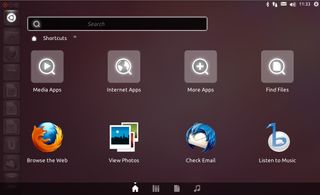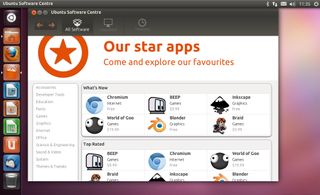Ubuntu vs. Windows 7 on the business desktop
Microsoft Windows may be the de facto standard desktop operating system in business environments, but high costs, restrictive licences and constant security issues are leading an increasing number of companies to consider open source alternatives — as Kat Orphanides explains.
The toolbar also has the Ubuntu Dash button, which works much like the Windows 7 Start menu.The rest of the toolbar's contents are context sensitive and change according to the application in focus. If the Desktop is active, for example it shows menus with shortcuts to key local directories and the rest of the network, options to create new folders and documents, and to change the appearance of the Desktop. With Firefox in active use though, the toolbar changes to show bookmarks, web browser tools and so on.
The toolbar also has the Ubuntu Dash button, which works much like the Windows 7 Start menu. When clicked, it opens a translucent window with shortcuts to key applications like the web browser and email client, along with shortcuts to application groups like internet' and media'.

These groups mix both installed and available-to-install software, with the latter option resulting in the appropriate download from the Ubuntu Software Centre, although it did mistakenly prompt for an installation disc in one isolated instance. The Dash also has a Search box that makes it easier to find a particular application on a system with lots of installed software.
Software Installation
Software installation is one area where Ubuntu trumps Windows for convenience, thanks to the complete online distribution of applications through its Software Centre and other third-party software repositories.
Managed by Canonical, the Ubuntu Software Centre provides downloads for a massive archive of Ubuntu-compatible programs and also provides a convenient interface for managing installed software. Applications can eve searched for by name or function, and also offers user ratings.

Everything the Software Centre provides is extensively tested and safe to install, but IT managers who would rather retain control over the applications their users are able to install can simply set-up accounts without privileged superuser' (or sudo') access.
Application and operating system updates are also delivered through the Software Centre, and notification updates are shown via the Updates icon on the Ubuntu Unity Launcher. Individual updates can be enabled here, as can updates only for important security fixes.
Get the ITPro. daily newsletter
Receive our latest news, industry updates, featured resources and more. Sign up today to receive our FREE report on AI cyber crime & security - newly updated for 2024.
If bandwidth is a concern, it's also possible to create an offline update repository that downloads files just once, and then redirect each Ubuntu PC to this instead.
This set-up compares extremely well to Microsoft Windows Server Update Services (WSUS), which performs a similar function for local software updates, but requires an administrator to perform time-consuming approvals for updates rolled out across a network.
K.G. is a journalist, technical writer, developer and software preservationist. Alongside the accumulated experience of over 20 years spent working with Linux and other free/libre/open source software, their areas of special interest include IT security, anti-malware and antivirus, VPNs, identity and password management, SaaS infrastructure and its alternatives.
You can get in touch with K.G. via email at reviews@kgorphanides.com.





